Ultra HD
Posted on November 8, 2013 by KVMG-CMS | 2 comments
Ultra High Definition television (Ultra HD) is a new standard that dramatically improves upon the picture quality and detail of Full HD. As people are buying larger and larger displays, there has been an increased demand for higher picture resolution.
In October 2012, the Consumer Electronics Association defined and approved the Ultra High Definition standard. Also known as UHD, Ultra HD is the 4K video resolution used for consumer displays. Compared with 1080p, Ultra HD has double the lines of vertical resolution and double the number of pixels of horizontal resolution, featuring a 3840x2160 resolution, while maintaining the 16:9 aspect ratio of home-entertainment TVs.
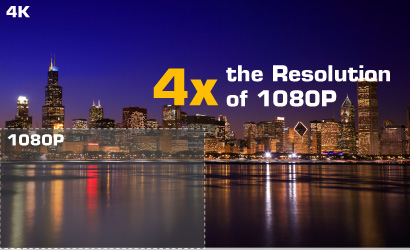
Ultra HD is the next logical step in the progression of display standards, and will be around for a long time.
4K is a high-definition video resolution standard allowing about four times the resolution of 1080p signals - up to 4096 x 2160 at 24Hz. Formerly only used for digital projection in theaters, it is becoming a new standard for home theater displays as well.
4K refers to approximately 4,000 pixels of horizontal resolution, in contrast to standard digital TV resolutions which are stated in vertical lines. If 1080p has 1080 lines of vertical resolution (1920x1080), 4K video has 2160 - double the lines of vertical resolution.
For consumer displays, 4K (also known as Ultra HD [UHD]) video has double the lines of vertical resolution and double the number of pixels of horizontal resolution (3840x2160), maintaining the 16:9 aspect ratio of home-entertainment TVs.

For shooting major motion pictures as well as for cinema theater projection, the film industry likes to shoot at resolutions at least 3-4 times greater than what it will project, so the Digital Cinema Initiative (DCI) backed by the major Hollywood studios came out with a 4K specification (at the same time it came out with the 2K display specification). DCI's 4K has 2160 vertical lines of resolution, which is double that of 1080p, and 4096 pixels of horizontal resolution (4096x2160), which is exactly double that of 2K, thus maintaining the 17:9 aspect ratio that better aligns with several of 35mm and 70mm films formats used to shoot and project movies.
2K is a high-definition video resolution standard that allows slightly higher resolution than 1080p signals - up to 2048x1080.
2K refers to horizontal resolution, in contrast to standard digital TV resolutions which are stated in vertical lines. If 1080p has 1080 lines of vertical resolution (1920x1080), 2K has the same number of lines of vertical resolution with slightly more pixels of horizontal resolution (typically 2048x1080).
2K is mostly used to rate digital cinema formats, since the Digital Cinema Initiative (DCI) backed by the major Hollywood studios uses a 17:9 aspect ratio that better aligns with several of 35mm and 70mm films formats used to shoot and project movies.
Ultra HD TVs offer four times the resolution of 1080p HDTVs (twice as many pixels in each direction, horizontally and vertically). The decreased pixel size of Ultra HD TVs dramatically improves picture clarity. Meanwhile, Ultra HD's deeper, broader color palette makes everything you watch more vibrant and lifelike, giving you a phenomenal viewing experience.
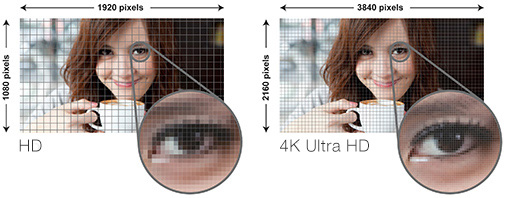
Ultra HD helps create a movie theater quality experience right in your living room. With Ultra HD, the pixels are so small that you can still experience a seamless picture at a closer viewing distance. The high resolution of Ultra HD increases picture quality in large displays, enabling you to get closer without noticing pixels. For example, you can sit closer to an 84" Ultra HD TV than to a 46" 1080p HDTV. With double the resolution and deeper, richer colors, Ultra HD gives you the ultimate, smooth picture.
Ultra HD can also improve small displays, providing you with more definition in the same sized screen.
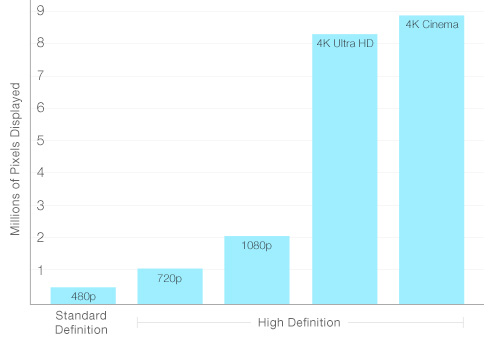 The increased resolution made possible by 4K Ultra HDs (8.3 million pixels vs. Full HDs 2.2 million) enhances picture quality by reducing gaps between pixels and visible pixels. This sharpens detail and shows smoother lines so that even up-close images seem clearer, more realistic, and less pixilated.
The increased resolution made possible by 4K Ultra HDs (8.3 million pixels vs. Full HDs 2.2 million) enhances picture quality by reducing gaps between pixels and visible pixels. This sharpens detail and shows smoother lines so that even up-close images seem clearer, more realistic, and less pixilated.
The amount of content available now may seem limited, but that will change. The advancement of Ultra HD cameras provides the opportunity to record and edit in Ultra HD. Starting in May, 2013, a select number of Sony Pictures Blu-ray discs optimized for Ultra HDTVs (labeled "Mastered in 4K") became available, with more to follow later in the year.
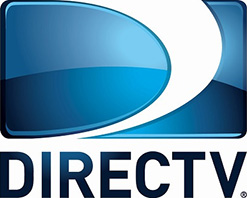 Even with un-optimized HD content, your Ultra HD TV will be able to up-convert the picture and fill in the remaining pixels to give you a phenomenal experience. And if you have a camera that shoots 8 megapixels or more, you're already recording Ultra HD content.
Even with un-optimized HD content, your Ultra HD TV will be able to up-convert the picture and fill in the remaining pixels to give you a phenomenal experience. And if you have a camera that shoots 8 megapixels or more, you're already recording Ultra HD content.
A few networks around the world are already broadcasting Ultra HD. Eutelsat Communications launched the first Ultra HD demo channel in Europe in January 2013, on its EUTELSAT 10A satellite. In the UK, the BBC has plans to film some documentaries with 4K equipment in 2013.
Just as Planet Earth was one of the first programs to be shown in HD, the BBC's Natural History Unit have been handed the task of filming Survival in Ultra HD, while the 2014 World Cup Final from Brazil will be shown in Ultra HD to satellite viewers in Japan.
DIRECTV has already trademarked five different Ultra HD channels; 4K, 4KN, 4KNet, 4K Network, and 4KNetwork.
 And Netflix, being that it wants to become a major provider of 4K content next year, has begun in November 2013 testing out 4K video streaming, posting a handful of short videos intended to demonstrate ultra high-definition capabilities.
And Netflix, being that it wants to become a major provider of 4K content next year, has begun in November 2013 testing out 4K video streaming, posting a handful of short videos intended to demonstrate ultra high-definition capabilities.
Keep an eye out for 4K Ultra HD content coming in the form of:
- Broadcast TV
- 4K Ultra HD Blu-ray discs
- 4K Ultra HD media players
- 4K Ultra HD Streaming content
KVMGalore is now providing the tools you need to upgrade your system to Ultra HD 4K resolutions. KVMGalore carries a full line of 4K-compatible Ultra HD splitters, switches, extenders and matrix-switches for various top-notch manufacturers.
HDMI is an excellent, uncompressed medium for delivery of 4K content suitable for a variety of environments. Whether it's a simple home theater, or a large video distribution network, our Ultra HD products are designed for simple plug-and-play installation, while including the pro features you expect from KVMGalore.
More HDTV splitters, switches, extenders, matrixes and cables that support Ultra HD are gradually coming to market. Look for them in the Ultra HD product line under Home Theater.
Click on the SPECS tab of any HDTV product - if you see the  icon - this product is Ultra HD compatible.
icon - this product is Ultra HD compatible.
Upgrading your system to 4K provides massive benefits in picture resolution, and dramatically "ups" the visual impact to your clients and customers. Create striking digital signage displays, high-impact corporate presentations and more, with the help of KVMGalore's Ultra HD compatible products.
Steve, owner of a modest-sized indoor/outdoor gardening store, wanted an effective way to improve the look of their outdoor video kiosks, which are located in custom enclosures on the end caps of the isles.
Customers often get very close to the kiosks, and have complained about text looking blurry. They originally featured 60" vertical 1080p displays, and are used to alternate between a short video, and an informational page showing specials and new items.
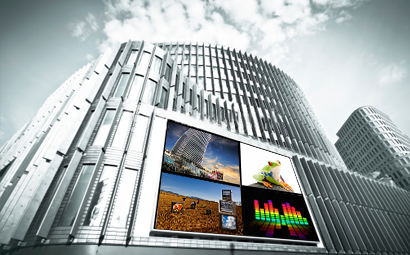 During the upgrade process, Steve chose to replace the displays with 60" Ultra HD LED displays to help with the problem. The PC that powers the kiosks has a video card that supports 4K resolution, so right away the text looked crisp and sharper than before. His HD video splitter was upgraded to one supporting a 4K signal.
During the upgrade process, Steve chose to replace the displays with 60" Ultra HD LED displays to help with the problem. The PC that powers the kiosks has a video card that supports 4K resolution, so right away the text looked crisp and sharper than before. His HD video splitter was upgraded to one supporting a 4K signal.
Steve was able to get a 2K export of his video, which also looked noticeably sharper compared to the old 1080p displays. The reason for this is that the high quality scalers improve upon 2K and 1080p by using special algorithms to properly distribute and smooth the pixels across the higher resolution, with stunning results.
Many people who have businesses like Steve's are now upgrading to Ultra HD to take advantage of its expanded definition that offers incredible possibilities and many benefits for business applications.
- With an already high number, and growing quickly, of 4K-capable cinemas more and more films are being converted into 4K digital masters. It's not just films that are being converted, more and more television shows are being shot in 4k as well.
- 4K is much closer to at home cinema feel than 2k. It is the only way you can see almost exactly what the people who created the film wanted you to see, which makes it irresistible to serious film fans.
- Detail. 4K delivers detail that 2k and Full HD can't touch. 4K resolution is in a completely different league to 1080p (Full HD) or 2k, having 4096 x 2160 pixels to work with lets displays reproduce subtle details and even texture. So many pixels of detail increases the draw distance of pictures and the images appear 3D to the viewer when they are not.
- 4K TVs include a format called xvYcc, which allows them to show a wider range of colors than current TVs.
- Fantastic for sporting events. 4K Ultra HD allows you to zoom in much closer to the action, without losing so much clarity. Great for the viewer at home and for the referees making key calls during game time.
- Not as expensive as you think Sony's 55" and 65" Class 4k Ultra HD 3D Ready LED TV's are mainstreamed sized screens at modest prices.
Bottom line: This technology will make you smile simply because it is so impressive. The picture is beyond fantastic compared to anything we have now. The colors will amaze you and you will see detail and texture on images that you have never seen before. 4K Ultra HD is awesome. If you don't believe so just stop into an electronics store near you and view it with your own eyes; you may want to bring some popcorn.
Need help? Call KVMGalore at 1-800-636-3434 or submit your question.







Is there a difference between 4K and Ultra HD?
Technically, "Ultra HD" and "4K" are different (see links for precise definitions). However, for all intent and purpose of the home entertainment industry, "Ultra HD" and "4K" are typically being used interchangeably. They both refer to a 16:9 format that is horizontally double and vertically double the 1080p standard, achieving a resolution of 3840x2160.